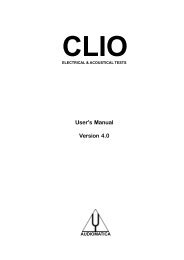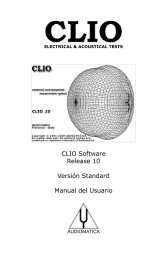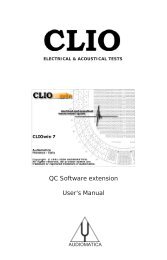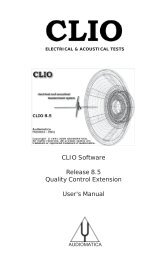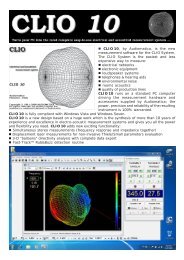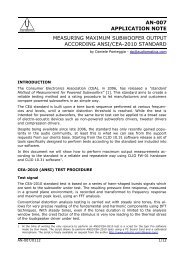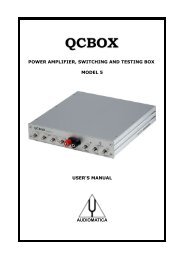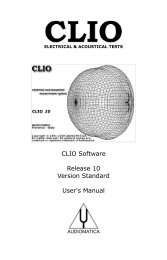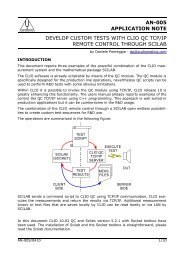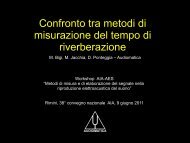CLIOwin 7 PCI User's Manual - Audiomatica
CLIOwin 7 PCI User's Manual - Audiomatica
CLIOwin 7 PCI User's Manual - Audiomatica
Create successful ePaper yourself
Turn your PDF publications into a flip-book with our unique Google optimized e-Paper software.
it is necessary to remove the flight time plus the device settling time; this can be easily<br />
accomplished setting the internal trigger delay, in FFT settings, to 1.5ms; the final result<br />
shown is shown in 11.11 and permits the identification of the device harmonic distortion.<br />
To proceed further one could vary the stimulus amplitude and test the distortion of the<br />
tweeter at different amplitudes; using bursts also prevents the damage of the unit as<br />
the overall power delivered to it rather low and a direct function of the duty cycle of the<br />
burst itself.<br />
The main application of RTA analysis is in assessing the quality of an audio installation<br />
(from the placement of the speakers in a listening room to the overall sound quality of<br />
a car stereo system). In these cases pink noise is often used as the stimulus. If you<br />
are not using CLIO as the source of such a stimulus be sure to use a good one; you<br />
may find several audio generators that do the job, but they are usually expensive. A<br />
good choice is to use a recorded track of one of the various test CDs available; in this<br />
case not all the CD-ROM readers may furnish adequate results, as appears from the<br />
graph in Fig.9.3<br />
0.0<br />
CLIO<br />
dBV<br />
-20.0<br />
-40.0<br />
-60.0<br />
-80.0<br />
-100.0<br />
20 100 1k Hz<br />
10k 20k<br />
Figure 9.3<br />
All three graphs represent true analog pink noise, they are played at intervals of 5dB<br />
for clarity. The upper (red) is the output of an Audio Precision System One generator;<br />
the second (blue) is the pink noise of track 4 of the Stereophile Test CD played by a<br />
Philips CD692 CD player, the third is the same track of the same test CD output by the<br />
computer which I'm writing with right now (Pioneer DVD Player plus Crystal Sound<br />
Fusion <strong>PCI</strong> Audio).<br />
When taking RTA measurements use, at least, 16k FFT size if you want to cover<br />
the entire 20-20kHz audio band; using lower sizes results in octave bands not<br />
present as no FFT bins fall inside them.<br />
100 Chapter 9 - FFT



